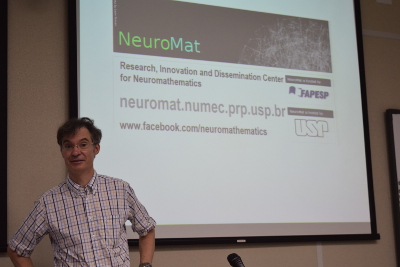
Goals, challenges and horizons of spike sorting
Newsletter | Dec 16, 2014
 |
How do we distinguish the activity of one or more neurons in a set of recorded neural activity? How do we assign spikes to different neurons? What mathematical, computational tools are available to sort spikes? These questions, among others, informed a three-day-long training on spike sorting that FAPESP's Research, Innovation and Dissemination Center for Neuromathematics (CEPID NeuroMat) hosted in São Paulo at the end of November (25-27), with Prof. Christian Pouzat, a researcher of the Applied Maths Laboratory of the Paris-Descartes University and a specialist in spike sorting.
LimeSurvey, a key tool for open-science data building
Newsletter | Nov 06, 2014
The NeuroMat technology-transfer team has been active in the creation and spreading of free and open-source software tools and materials on how to use efficiently these tools. Such activities are in tune with the commitment that NeuroMat, the Research, Innovation and Dissemination Center for Neuromathematics, has embraced in relying exclusively on open-science tools and becoming a reference in open science.
NeuroMat develops an open-source software for the management of neuroscience experimental data
Newsletter | Oct 31, 2014
The Research, Innovation and Dissemination Center for Neuromathematics (CEPID NeuroMat) software development team released in October the first module of Neuroscience Experiments System (NES), an open-source tool to manage clinical data gathered in hospitals and research institutions.
NeuroMat releases report of first-year activities
Newsletter | Oct 31, 2014
NeuroMat released at the end of September the First Report of Activities. This document is required by the São Paulo Research Foundation (FAPESP), the funding entity of the Research, Innovation and Dissemination Center for Neuromathematics (CEPID NeuroMat), and presented detailed accounts of scientific, dissemination and technology-transfer activities.
NeuroMat researcher develops Bayesian models to make sense of brain patterns in EEGs
Newsletter | Oct 01, 2014
The challenge of developing Bayesian statistical models to make sense of brain patterns registered in Electroencephalograms (EEGs) is the ongoing effort of the Research, Innovation and Dissemination Center for Neuromathematics (CEPID NeuroMat) post doctoral fellow Michelle Ferreira Miranda. Her research is being conducted in a partnership with neuroscientists of the Institute of Neurology Deolindo Couto, from the Federal University of Rio de Janeiro (INDC/UFRJ), who are also part of the NeuroMat research team.
| NeuroCineMat |
|---|
|
Featuring this week: |
| Newsletter |
|---|
|
Stay informed on our latest news! |
| Follow Us on Facebook |
|---|




